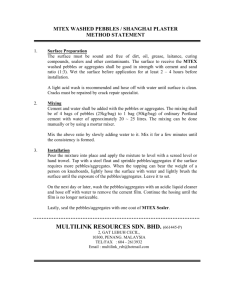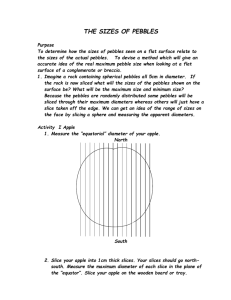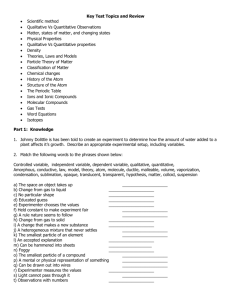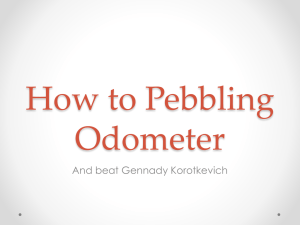Gen. Math. Notes, Vol. 5, No. 2, August 2011, pp.... ISSN 2219-7184; Copyright © ICSRS Publication, 2011
advertisement
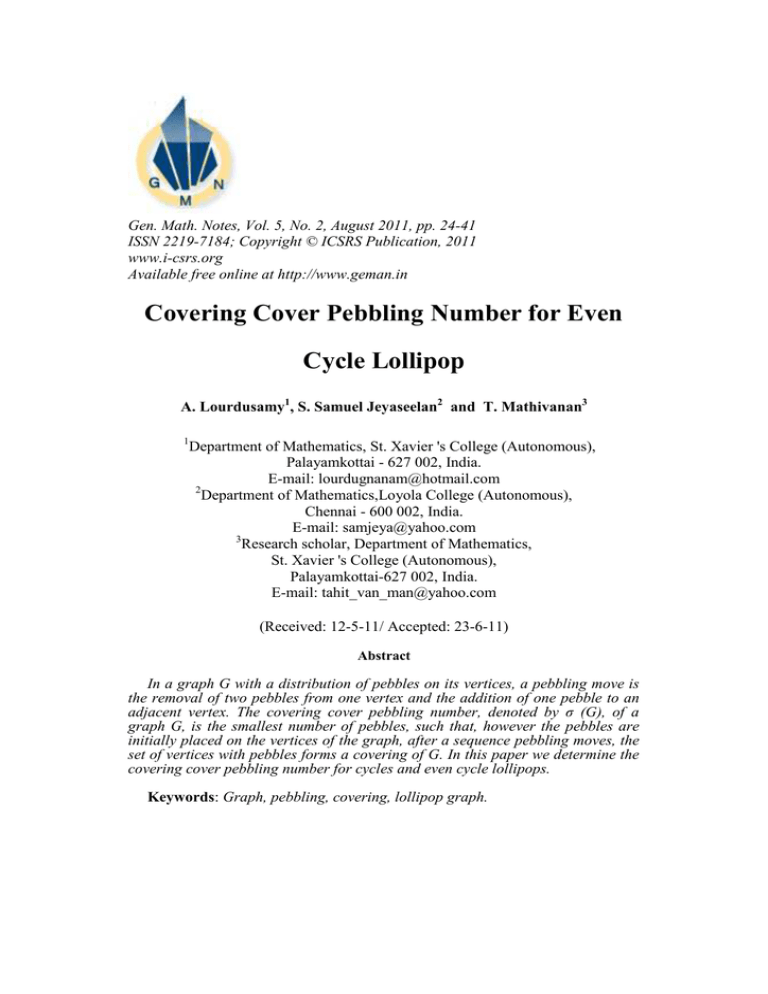
Gen. Math. Notes, Vol. 5, No. 2, August 2011, pp. 24-41
ISSN 2219-7184; Copyright © ICSRS Publication, 2011
www.i-csrs.org
Available free online at http://www.geman.in
Covering Cover Pebbling Number for Even
Cycle Lollipop
A. Lourdusamy1, S. Samuel Jeyaseelan2 and T. Mathivanan3
1
Department of Mathematics, St. Xavier 's College (Autonomous),
Palayamkottai - 627 002, India.
E-mail: lourdugnanam@hotmail.com
2
Department of Mathematics,Loyola College (Autonomous),
Chennai - 600 002, India.
E-mail: samjeya@yahoo.com
3
Research scholar, Department of Mathematics,
St. Xavier 's College (Autonomous),
Palayamkottai-627 002, India.
E-mail: tahit_van_man@yahoo.com
(Received: 12-5-11/ Accepted: 23-6-11)
Abstract
In a graph G with a distribution of pebbles on its vertices, a pebbling move is
the removal of two pebbles from one vertex and the addition of one pebble to an
adjacent vertex. The covering cover pebbling number, denoted by σ (G), of a
graph G, is the smallest number of pebbles, such that, however the pebbles are
initially placed on the vertices of the graph, after a sequence pebbling moves, the
set of vertices with pebbles forms a covering of G. In this paper we determine the
covering cover pebbling number for cycles and even cycle lollipops.
Keywords: Graph, pebbling, covering, lollipop graph.
Covering Cover Pebbling Number…
1
25
Introduction
Pebbling, one of the latest evolutions in graph theory proposed by Lagarias and
Saks, has been the topic of vast investigation with significant observations.
Having Chung [1] as the forerunner to familiarize pebbling into writings, many
other authors too have developed this topic. Hulbert published a survey of
pebbling results[3]. Given a connected graph, distribute certain number of pebbles
on its vertices in some configuration. Precisely, a configuration on a graph G is a
function from V (G) to N ∪ {0} representing a placement of pebbles on G. The
size of the configuration is the total number of pebbles placed on the vertices.
Support vertices of a configuration C are those on which there is at least one
pebble of C. In any configuration, if all the pebbles are placed on a single vertex,
it is called a simple configuration. A pebbling move is the removal of two pebbles
from one vertex and the addition of one pebble to an adjacent vertex. In (regular)
pebbling, the target vertex is selected and the aim is to move a pebble to the target
vertex. The minimum number of pebbles, such that regardless of the target vertex,
we can pebble that target vertex is called the pebbling number of G. In cover
pebbling the aim is to cover all the vertices with pebbles, That is, to move a
pebble every vertex of the graph simultaneously. The minimum number of
pebbles required such that, regardless of their initial placement on G, there is a
sequence of pebbling moves, at the end of which, every vertex has at least one
pebble on it, is called the cover pebbling number of G. In [2], the cover pebbling
number for complete graphs, paths and trees are determined. The covering cover
pebbling number, denoted by σ (G), of a graph G, is the smallest number of
pebbles, such that, however the pebbles are initially placed on the vertices of the
graph, after a sequence pebbling moves, the set of vertices with pebbles forms a
covering of G. The concept of covering cover pebbling number was introduced by
A.Lourdusamy and A.Punitha Tharani in [5] and they determined the covering
cover pebbling for complete graphs, paths, wheel, star graph,complete r-partite
graph and binary trees.
In this paper we determine the covering cover pebbling number for cycles in
Section 2. With regard to the covering cover pebbling number of cycles, we find
the following theorem in [5].
Theorem 1.1[5] Let Pn be a path on n vertices with V = V(Pn) = {v1, v2, v3,…, vn-
2n − 1
1, vn} and E=E(Pn)={v1v2, v2v3, v3v4,…, vn-1vn}. Then σ ( Pn ) =
3
In Section 3, we then present the covering cover pebbling number for even cycle
lollipop.
26
2
A. Lourdusamy et al.
Covering Cover Pebbling Number for Cycles
We begin by proving that placing all the pebbles on one vertex is a “worst case”
configuration that determines the covering cover pebbling number of cycles.
Lemma 2.1 The value of σ (Cm) is attained when the original configuration
consists of placing all the pebbles on a single vertex, where Cm : v0v1v2 . . . vm −1v0
is a cycle on ‘m’ vertices.
Proof. Assume first that a worst configuration consists of more than one set of
consecutively pebbled vertices (“islands”). The maximum number of vertices in
each island is at most two. Suppose if any one of the islands consists of three or
more pebbled vertices, one could rearrange all the pebbles to the inner one or two
vertices of the same island, thereby causing a larger number of pebbles to be
needed to cover the edges-a contradiction. Thus, each “island” consists of at most
two vertices.
Now, consider the effect of relocating all the pebbles onto a single island. Once,
again, we get a contradiction to the fact that there could be more than one island,
because we need more pebbles to cover the edges of the graph, after relocating all
the pebbles onto a single island. So, our assumption (that a worst configuration
consist of more than one island) is wrong.
Next, assume that, the island consists of exactly two vertices. Clearly, a worst
initial configuration of pebbles is obtained by placing σ − 1 pebbles on one vertex,
say v1 and placing one pebble at an adjacent vertex of v1, say v2 , since, we need
more pebbles to cover the edges of the cycle. Note that, after the distribution of
(σ − 1, 1) pebbles to {v1, v2} respectively, we cover all the edges of the cycle.
But if we put all the pebbles on v1, we cannot cover at least one edge of the cycle.
Hence the result follows.
Since placing all the pebbles on a single vertex is a worst case, we now determine
the value of σ (Cm).
Theorem 2.2 Let Cm : v0v1v2 . . . vm −1v0 be a cycle on ‘m’ vertices. Then
2k + 2 − 5
, if m = 2k (k ≥ 2)
3
σ (Cm ) =
2k −1, if m = 2k −1(k ≥ 2)
Proof. By Lemma 2.1, we assume all σ(Cm) pebbles are on v0 ∈ Cm. If m = 2k (k
≥ 2), consider the paths PA and PB where PA = v0v1 . . . vk − 1vk and PB =
v0v2k−1v2k−2 . . . vk . We can cover the edges of the paths PA and PB, using 2σ(Pk+1)
Covering Cover Pebbling Number…
27
pebbles, since l(PA) = l(PB) = k (Figure C2k) and
1
σ ( Pn ) = (2 n − 1) ,
3
where Pn denotes a path on n vertices. Note that, v0 may be pebbled twice. This
happens only when k is odd. Since if k is odd, then the path Pk+1 is of odd length.
That is, both PA and PB are of odd length implies v0 is pebbled twice.
Thus,
2σ ( Pk +1 ), if k is even
σ (C 2k ) =
2σ ( Pk +1 ) − 1, if k is odd
2 k +1 − 2
, if k is even
2
3
=
2 k +1 − 1
− 1, if k is odd
2
3
2k + 2 − 4
, if k is even
3
=
2k +2 − 5
, if k is odd
3
2 k + 2 − 5
Therefore, σ (C2k) =
3
v1
v2
v3
vk-3
vk-2
vk-1
v0
vk
v2k-1
v2k-2
v2k-3
vk+3
The Cycle C2k (k ≥ 2)
vk+2
vk+1
28
A. Lourdusamy et al.
v3
v2
v1
vk-3
vk-2
vk-1
v0
v2k-2
v2k-4
v2k-3
vk+2
vk+1
vk
The Cycle C2k-1 (k ≥ 2)
Now, consider the case when m = 2k − 1 (k ≥ 2). Also consider the paths PA and
PB where PA = v0v1 . . . vk − 1vk and PB = vkvk+1 . . . v2k−2 v0. We can cover the
edges of the paths PA and PB using σ(Pk+1) and σ(Pk) pebbles respectively, since
l(PA) = k and
l(PB) = k − 1(Figure C2k-1).
It is easy to see that we do not pebble v0 twice. Therefore,
σ(C2k − 1) = σ(Pk+1) + σ (Pk)
2 k +1 − 2 2 k − 1
, if k is even
+
3
3
=
2 k +1 − 1 2 k − 2
, if k is odd
+
3
3
=
2 k +1 + 2 k − 3
, if k is even
3
2 k +1 + 2 k − 3
, if k is odd
3
3(2k −1)
=
, k≥2
3
k
Thus, σ(C ) = 2 −1 .
2k−1
Covering Cover Pebbling Number…
29
Therefore,
2k + 2 − 5
, if m = 2k (k ≥ 2)
3
σ (Cm ) =
2k −1, if m = 2k −1(k ≥ 2)
3
Covering Cover Pebbling Number for Even Cycle
Lollipops
We proceed to determine the covering cover pebbling number for a class of
unicyclic graphs, called a class of even cycle lollipop graphs.
Definition 3.1 [4] For a pair of integers m ≥ 3 and n ≥ 2, let L(m, n) be the
Lollipop graph of order m + n - 1 obtained from a cycle Cm by attaching a path of
length n − 1 to a vertex of the cycle.
If the cycle Cm in L(m,n) is even, then we call L(m,n) an even cycle
lollipop. We will use the following labeling for the graphs Cm and Pn:
Let Cm = v0v1v2…vm-1v0 and Pn = v0v p v p ...v p
1
2
n −1
be the cycle and the
path available in L(m,n).
Theorem 3.2 Let L(m, 2) be a lollipop graph, where m = 2k (k≥2).
Then, σ(L(m, 2)) =
2σ (C m ) + 1, if m = 2k with k ≥ 2 is even
2σ (C m ) , otherwise
Proof. Consider the Lollipop graph L(m,2).
Case1 Let m = 2k, where k ≥2 is even
Consider the distribution of 2σ(Cm) pebbles on v p . Clearly, we cannot cover at
1
least one of the edges of L(m, 2). Thus, σ(L(m, 2)) ≥ 2σ(Cm) + 1.
30
A. Lourdusamy et al.
v2k-1
v2k-2
v0
vp1
v1
v2
Now, consider the distribution of 2σ(Cm) + 1 pebbles on L(m, 2).
Case(1A) Cm contains at least σ(Cm) pebbles.
If either v p or v0 contains a pebbles on it, then we are done (by our assumption).
1
So, assume both v0 and v p have zero pebbles on it. Now, all the 2σ(Cm) + 1
1
pebbles are on V(Cm) − {vo}. We can cover the edges of Cm using at most σ(Cm)
pebbles. So, we have σ(Cm) + 1 remaining pebbles to pebble the vertex v0. Since
v0 has no pebbles on it, both v2k − 1 and v1 contain at least one pebble each while
using σ(Cm) + 1 remaining pebbles. But, if any one of the vertices of {v2k-1 , v1}
contains two or more pebbles, then we are done. So, both v2k−1 and v1 have
exactly one pebble each. Now, consider the paths PA = v2v3 . . . vk and PB = vkvk+1
. . . v2k −2 which are of length k −2 each. Then, any one of the paths contains at
least
σ (C m ) − 2
= σ ( Pk +1 ) − 1 =
2
2k +1 − 2
2 k +1 − 5 k −1
−1 =
≥2
, where the first inequality follows
3
3
since σ (Cm )
even.
= 2σ ( Pk +1) and the last inequality follows since k≥4 is
(Note that, if k = 2, v2 is the only remaining vertex in the cycle C4 and we are
done).
Covering Cover Pebbling Number…
31
Since, l(PA) = l(PB) = k − 2, we can move two pebbles to either v2k − 2 or v2 from
the path PB or PA which contains at least 2k −1 pebbles. So, we can put a pebble at
v0 and we are done.
Case (1B) Cm contains x < σ (Cm) pebbles.
There are at least 2σ (Cm) + 1 − x pebbles at v p . We can move
1
2σ (C m ) − x
pebbles to v0.
2
x
σ (C m ) −
2
That is,, from v p , we can move at least
1
pebbles to v0. Now we have at least x+ σ (Cm) -
x
2
pebbles in Cm and we are done. So, σ(L(m, 2) ≤ 2 σ(Cm) + 1.
Therefore, σ(L(m, 2) = 2 σ(Cm) + 1 if m=2k and k is even.
Case2 Let m=2k, where k≥3 is odd.
Consider the distribution of 2σ(Cm)-1 pebbles on v p . Clearly we cannot cover at
1
least one of the edges of L(m,2). So, σ(L(m,2))≥2σ(Cm).
Let us now prove that σ(L(m,2))≤2σ(Cm). Consider the distribution of 2σ(Cm)
pebbles on L(m,2).
Case (2A) Cm contains at least σ(Cm) pebbles.
If either v p or v0 contains a pebble on it, then we are done (by our assumption).
1
So, assume both v0 and v p have zero pebbles. Now, all the 2σ(Cm) pebbles are
1
on V(Cm) − {vo}. We can cover the edges of Cm using at most σ(Cm) pebbles.
So, we have σ(Cm) remaining pebbles to pebble the vertex v0. Since v0 has zero
pebbles on it, both v2k − 1 and v1 contain at least one pebble each while using
σ(Cm) remaining pebbles. But, if v2k-1 or v1 contains two or more pebbles, then
we are done. So, both v2k−1 and v1 have exactly one pebble each. Now, consider
the paths PA = v2v3 . . . vk and PB = vkvk+1 . . . v2k −2. Note that PA and PB are of
length k −2 each.
Then, any one of the paths contains at least
σ (C m ) − 2
= σ ( Pk +1 ) − 1=
2
32
A. Lourdusamy et al.
2k +1 − 1
2 k +1 − 4 k −1
≥2
−1 =
3
3
pebbles, where the last inequality
follows since k≥3 is odd.
Since, l(PA) = l(PB) = k − 2, we can move two pebbles to either v2k − 2 or v2 from
the path PB or PA which contains at least 2k −1 pebbles. So, we can put a pebble at
v0 and we are done.
Case (2B) Cm contains x < σ(Cm) pebbles.
There are at least 2σ(Cm) − x pebbles at v p . From these pebbles, we can send
1
2σ (C m ) − x −1
pebbles to v0.
2
2σ (C m ) − ( x + 1)
x + 1
= σ(Cm) −
That is,
2
2
Now, Cm has at least x + σ(Cm)
x + 1
−
2
≥ σ(Cm) pebbles and we are
done.
Thus σ(L(m, 2)) ≤ 2 σ(Cm).
Therefore, σ(L(m, 2)) = 2 σ(Cm), if m=2k and k is odd.
Theorem 3.3 Let L(m,n) be a Lollipop graph where m = 2k ≥ 4 and n ≥ 3. Then
σ(L(m,n))=
2n −1σ (C ) + σ ( P ), if m = 2k with k ≥ 2 is even
m
n
n −1
σ (Cm ) + σ Pn −1 , otherwise
2
(
)
Proof. Consider the Lollipop graph L(m,n) where m = 2k ≥ 4 and n ≥ 3.
Case1 Let m = 2k with k ≥ 2 is even and n ≥ 3.
Consider the distribution of 2n − 1σ(Cm)+σ(Pn)−1 pebbles on the vertex v p
.
n −1
Clearly we cannot cover at least one of the edges of L(m, n). Thus, σ(L(m, n)) ≥
2n−1σ(Cm )+ σ(Pn) .
Covering Cover Pebbling Number…
Now, consider the distribution of
n).
33
2n −1σ (Cm ) + σ (Pn ) pebbles on L(m,
Case (1A) Cm contains σ(Cm) or more pebbles.
If Pn contains σ(Pn) pebbles then we are done. So assume that Pn contains less
than σ(Pn) pebbles. So, Cm contains at least 2n −1 σ(Cm) + σ(Pn) − (σ(Pn) − 1) = 2n
−1
σ(Cm) + 1 pebbles. From these pebbles we used at most σ(Cm) pebbles to cover
the edges of Cm. We have at least (2n−1 −1) σ (Cm) + 1 pebbles in Cm to cover the
edges of Pn. Now, consider the paths PA : v0v1 . . . vk-2vk-1 and PB : vkvk+1 . . . v2k-1.
Now we see that either PA or PB contains
(2 n −1 − 1)σ (C )
m + 1pebbles.
2
(2 n −1 − 1)σ (C )
m + 1 ≥ 2k-1 σ(P )
Then we claim that,
n
2
Suppose not, then.
(2 n −1 − 1)σ (C )
m + 1 < 2k-1 σ(P )
n
2
( 2n − 2)σ ( P )
k +1 + 1 < 2k-1 σ(Pn)
That is,
2
( 2 n − 2)
That is,
2
2 k +1 − 2
+ 1 < 2k-1 σ(Pn)
3
( 2 n − 2)
That is,
3
2 k +1 − 2
+ 1 < 2k-1 σ(Pn)
2
34
A. Lourdusamy et al.
2 n − 2
2 n −1
k
k-1
That is,
( 2 − 1) + 1 < 2
3
3
which is a contradiction, since k ≥ 2 and n ≥ 3.
So, either PA or PB contains at least 2k −1σ(Pn) pebbles. If PA contains 2k −1σ(Pn)
pebbles then we are done (since l(PA) = k − 1 and v0 ∈ PA). So, assume that PB
contains at least 2k −1σ(Pn) pebbles. Also, note, if PB contains 2kσ(Pn) pebbles
then we are done. So, assume PB contains less than 2kσ(Pn) pebbles. This implies
that PA contains at least (2n−1 – 1)σ(Cm) + 1 − (2k σ(Pn) – 1)
= (2n−1 – 1)σ(Cm) − 2k σ(Pn) +2 pebbles
But,
(2n−1 – 1)σ(Cm) − 2k σ(Pn) +2
= (2n−1 – 1)
[2σ ( Pk +1 )] − 2 σ(P ) + 2
k
n
since m = 2k and k is even
2n − 1
2k +1 − 2
n
k
+ 2 if n is even
(2 − 2)
−2
3
3
=
2k +1 − 2
2n − 2
n
k
+ 2 if n is odd
−2
(2 − 2)
3
3
k
2n − 2
2
k
k
( 2.2 − 2 − 2 ) −
+ 2 , if n is even
3
3
=
2n − 2
( 2.2k − 2 − 2k ) + 2 , if n is odd
3
Covering Cover Pebbling Number…
35
2n − 2
2k
k
(2 − 2) −
+ 2 , if n is even
3
3
=
2n − 2 k
(2 − 2) + 2 , if n is odd
3
2n − 2
2k
k
≥
( 2 − 2) −
3
3
So we can send at least
2 n − 2
k
( 2 − 2)
k
3
2
−
k
−
1
k
−
1
2
3. 2
pebbles
to v0
That is,
we send at least
≥
2 n − 2 2
−
3 3
2 n − 2
2 2
2−
−
3
k
−
1
3
2
pebbles to v0 where the inequality follows since k
≥ 2.
So, the minimum number of pebbles that we send to v0 is
2 n − 4
3
2 n − 2 − 1
= 4
3
36
A. Lourdusamy et al.
2 n − 2 − 1
≥ 4
3
≥ 4 σ (Pn−2)
= 2σ(Pn−2) + 2σ(Pn−2)
≥ 2 σ(Pn−2) + 2
= σ(Pn − 1) + 1, where the last inequality follows since σ(Pn) = 2 σ(Pn−1) + 1 or
2σ(Pn−1)
So, we send σ(Pn−1) + 1 pebbles to v0 from PA.
σ ( Pn )
2 ≥ σ(Pn−1) pebbles to v0 from PB.
Also we send
Thus we have 2 σ(Pn−1) + 1 pebbles
at v0 and we are done.
Case (1B) Cm contains x < σ(Cm) pebbles.
There are at least 2n−1 σ(Cm) + σ(Pn) − x pebbles on Pn. From these we use σ(Pn)
pebbles to cover the edges of Pn. Now we have at least 2n−1 σ(Cm) − x pebbles in
Pn. We have to use these pebbles to cover the edges of Cm. From these pebbles,
we can send
(2 n −1 )σ (C m ) − x
2 n −1
That is, v0 has at least σ(Cm) −
pebbles to v0.
x
2 n −1
Now, Cm contains at least x + σ(Cm) −
pebbles.
x
2 n −1
≥ σ(Cm) + x −
x
4
≥ σ(Cm)
pebbles, since n≥3 and so we are done.
Thus, σ(L(m, n)) ≤ 2n−1σ(Cm )+ σ(Pn) .
Therefore, σ(L(m, n)) = 2n−1σ(Cm )+ σ(Pn), if m=2k and k is even.
Case (2) Let m = 2k with k ≥ 3 is odd and n ≥ 3.
Consider the distribution of placing all the 2n−1 σ(Cm) + σ(Pn−1) − 1 pebbles
on v p
. Clearly we cannot cover at least one of the edges of L(m, n).
n −1
Covering Cover Pebbling Number…
37
Thus σ(L(m, n)) ≥ 2n−1σ(Cm) + σ(Pn−1)
Now, consider the distribution of 2n−1 σ(Cm) + σ(Pn−1) pebbles on L(m, n).
Case (2A) Cm contains at least σ(Cm) pebbles.
If Pn contains σ(Pn) or more pebbles then we are done. So, assume that Pn
contains less than σ(Pn) pebbles. This implies that Cm contains at least 2n−1 σ(Cm)
+ σ(Pn−1) − (σ(Pn) −1) pebbles.
That is, the minimum number of pebbles that Cm has is,
2n−1σ(Cm) + σ(Pn−1) − σ(Pn) + 1
=
2n −1σ (C ) + σ ( P ) − (2σ ( P + 1) + 1, if n is even
m
n −1
n −1
2n −1σ (Cm ) + σ ( Pn −1) − (2σ ( Pn −1) + 1, if n is odd
2 n −1σ (C ) − σ ( P ) if n is even
m
n −1
=
2 n −1σ (Cm ) − σ ( Pn −1) +1 if n is odd
≥ 2n−1 σ(Cm) − σ(Pn−1).
From these pebbles, we use σ(Cm) pebbles to cover the edges of Cm.
Consider the paths PA : v0v1v2 . . . vk−2vk−1 and PB : vkvk+1 . . . v2k − 1 of length k −
1 each. Then any one of the paths contains at least
(2 n −1 − 1)σ (C ) − σ ( P
)
m
n
−
1
2
pebbles.
That is, either PA or PB contains at least,
(2 n −1 − 1)σ (C ) − σ ( P
)
m
n
−
1
2
≥ 2k−1σ(Pn) pebbles.
38
A. Lourdusamy et al.
Suppose not, then,
(2 n −1 − 1)σ (C ) − σ ( P
)
m
n
−
1
2
< 2k−1 σ(Pn)
2 n −1 − 1
2 n −1 − 1
3
σ (C m ) −
3
3
< 2k−1 σ(P )
That is,
n
2
2 n −1 − 1 3σ (C ) − 1
m
That is,
3
2
< 2k−1 σ(Pn)
2 n −1 − 1 3(2.σ ( p
) − 1) − 1 k−1
k
+
1
That is,
< 2 σ(Pn)
3
2
(since m = 2k and k is odd)
2 n −1 − 1 2(3.σ ( p
) ) − 4
k
+
1
That is,
3
2
2 n − 2 3(2 k +1 − 1)
− 1
That is,
2(3)
3
< 2k−1σ(Pn)
< 2k−1σ(Pn) (since k is
odd)
2 n − 2
3
k
+
1
That is,
−
2
3
2
<2
k−1
σ(Pn) = 2
which is a contradiction, since k ≥ 3 is odd and n ≥ 3.
k−1
2 n − 1
3
Covering Cover Pebbling Number…
39
If PA contains at least 2k−1σ(Pn) pebbles, then we are done, since l(PA) = k−1.So
we assume that PB contains at least 2k −1σ(Pn) pebbles. Also, note that if PB
contains 2kσ(Pn) pebbles then we are done, since l(PB∪{v0}) = k). Assume that
PB contains less than 2kσ(Pn) pebbles. Then the minimum number of pebbles that
PA has is,
(2n−1 −1)σ(Cm) − σ(Pn−1) − (2kσ(Pn) −1)
=
(2n −1 − 1)σ (C ) − σ ( P ) − 2k (2σ ( P ) + 1) + 1if n is even
m
n −1
n −1
(2n −1 − 1)σ (Cm ) − σ ( Pn −1) − 2k (2σ ( Pn −1) + 1if n is odd
≥ (2n−1 −1)σ(Cm) − σ(Pn−1) − 2k+1σ(Pn-1)
= (2n−1 −1)σ(Cm) − ( 1+2k+1 )σ(Pn-1)
=
2 n −1 − 1
2 n −1 − 1
+
k
1
[3(2σ ( P
+ 1)
k +1 ) − 1] − (2
3
3
≥
n −1 − 1
2
2(2 k +1 − 1) − 3 − (2 k +1 + 1)
3
2 n −1 − 1
( 2 k +1 − 6)
=
3
2 n −1 − 1
2 k − 3 .
= 2
3
Thus the minimum number of pebbles that we can send to v0 is,
2 n −1 − 1
k
2
2 − 3
3
k
−
1
2
40
A. Lourdusamy et al.
2 n −1 − 1
3
2−
= 2
k
−
1
3
2
=
5 2 n −1 − 1
2
3
2 n −1 − 1 5
≥ 2
4
3
≥ 2 σ(Pn−1)
≥ σ(Pn−1) + 1 where the second inequality follows since k≥3.
σ ( Pn )
Also we can send
≥ σ(Pn−1) pebbles to v0 from the path PB. So, we have
2
at least 2σ(Pn−1) + 1 pebbles at v0. Thus we have enough pebbles to cover the
edges of the path Pn and we are done.
Case (2B) Cm contains x < σ(Cm) pebbles.
There are 2n−1σ(Cm) + σ(Pn−1) − x pebbles on Pn. we use σ(Pn) pebbles to cover
the edges of Pn. The number of pebbles remaining on Pn for the purpose of
covering the edges of Cm is
2n−1σ(Cm) + σ(Pn−1) − x − σ(Pn)
≥ 2n−1σ(Cm) + σ(Pn−1) − x − (2σ(Pn−1) + 1)
= 2n−1σ(Cm) − σ(Pn−1) − (x +1)
So, the minimum number of pebbles that we can send to v0 is,
2 n −1σ (C ) − σ ( P
) − ( x + 1)
m
n
−
1
−
n
1
2
2 n −1 − 1 ( x + 1)
≥ σ (C m ) −
−
n
−
1
n
−
1
3.2
2
1
1
x + 1
≥ σ (C m ) − −
−
n
−
1
3
4
3.2
Covering Cover Pebbling Number…
≥
41
x 7
(
C
)
−
−
σ
.
m
4 12
Now, the minimum number of pebbles that Cm has is,
x + σ(Cm) -
x 7
4 + 12
≥ σ(Cm) +
3x 7
−
4 12
≥ σ(Cm), where the last inequality follows since x > 0. So, we are done.
Thus, σ(L(m, n)) ≤ 2n−1 σ(Cm) + σ(Pn−1).
Therefore, σ(L(m, n)) = 2n−1σ(Cm) + σ(Pn−1).
References
[1]
[2]
[3]
[4]
[5]
[6]
[7]
[8]
F.R.K. Chung, Pebbling in hypercubes, SIAM J. Discrete Math, 2(4)
(1989), 467-472.
Crull, Cundiff, Feltman, Hulbert, Pudwell, Szaniszlo and Tuza, The Cover
Pebbling Number of Graphs, (Preprint).
G. Hulbert, A survey of graph pebbling, Congressus Numerantium, 139
(1999), 41-64.
K.M. Kathiresan and G. Marimuthu, Superior domination in graphs,
Utilitas Mathematica, 76 (2008), 173-182.
A. Lourdusamy and A. PunithaTharani, Covering cover pebbling number,
Utilitas Mathematica, 78 (2009), 41-54.
A. Lourdusamy and A. Punitha Tharani, Covering cover pebbling number
of hypercube and diameter d graphs, Journal of the Korea Society of
Mathematical Education Series B, The Pure and Applied Mathematics,
15(2) (40), May 2008.
A. Lourdusamy and S. Somasundaram, Pebbling C5xC5 using linear
programming, Journal of Discrete Mathematical Sciences and
Cryptography, 4(1) (2001), 1-15.
C. Xavier and A. Lourdusamy, Pebbling number in graphs, Pure and
Applied Mathematika Sciences, XLIII(1-2) (1996), 73-79.

